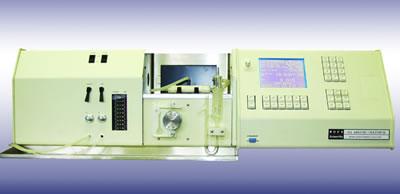|
Instrument Database:
Buck Scientific - 411 Arsenic Hydride Analyzer
| |
|

|
| |
|
| |
|
| Year of introduction |
2005 |
| Status |
available |
| Company |
Buck Scientific
|
| Categories |
Dedicated Analyzer: Ammonia
|
Detailed Product Information
Using the established platform from the Buck 210 Series AAS. The Unique Model 411 system provides high throughput determination of Arsenic from prepared water and solid waste samples using an integrated continuous flow hydride generator and electrically heated quartz tee tube for combustion of the hydride material for sub-PPB sensitivities in the most compact dedicated package.
Features
- Provides detection limits of 500 parts per trillion (0.5 parts per billion.)
- Enclosed, electrically heated quartz tee tube provides safe reaction of hydride generation products to give stable, hi energy arsenic signals.
- Fully integrated continuous flow hydride system provides simple operation with real-time sample data.
- Can be used with low cost technical grade argon or nitrogen purge gas with complete flow meter controls on instrument for optimizing the data.
- Internal software capable of multi-port linear and quadratic calibration curves with statistical analysis of sample data.
- Direct printout for 21-CFR part 11 compliance and optional data transfer software for PC data storage.
- Easy to operate with virtually nothing to adjust
- Unique in-line Deuterium corrector provides superior energy compared to any other arsenic method for the best accuracy and freedom from interferences
- Toll-free technical assistance and on-line application support.
Summary of Technology:
Typical Arsenic analytical methods usually involve either the time-consuming modification of an existing Flame AAS to accommo-date a hydride cell or using a costly graphite furnace AAS to reach low PPB levels needed for most environmental screening and remediation testing. The well known hydride generation reaction (based on the classic 100+ year old marsh test for arsenic) provides the best detection limits, since it serves to concentrate the arsenic and isolate it from any sample matrix. Tests can be performed with excellent reliability and throughput using the continuous flow method where the sample solution is pre-mixed with the appropriate hydrochloric sulfuric acid matrix then reacted with the strong sodium Borohydride reducing agent to create arsine (volatile arsenic hydride) and free hydrogen. This gas reaction is passed through the quartz cell heated over 600º to form free arsenic atoms which absorb the D2 corrected light from the Buck hi through output arsenic hollow cathode lamp to produce precise sub PPB level data in less than 60 seconds with the push of a button.
|
| Specifications |
|
| Detection
Limits: |
500
PPT (based on standard
peristaltic pump tubing) |
| Reaction
Cell: |
150mm
Annealed Quartz
T-Tube, sealed
Electrical Heater |
| Power
Requirements: |
110V/20A
for U.S. operation
& 220V/10A for
International |
| Dimensions: |
39"W
x 11"D x
12" H |
| Weight: |
60
lbs. |
|
Output: |
Printer
(parallel port)
Digital (RS-232)
and 1V Analog |
| Background
Corrections: |
In-Line
Deuterium Lamp
(automatic compensation) |
| Reaction
System: |
Peristaltic
pump with phase
separation glassware
& gas delivery
lines |
|
|